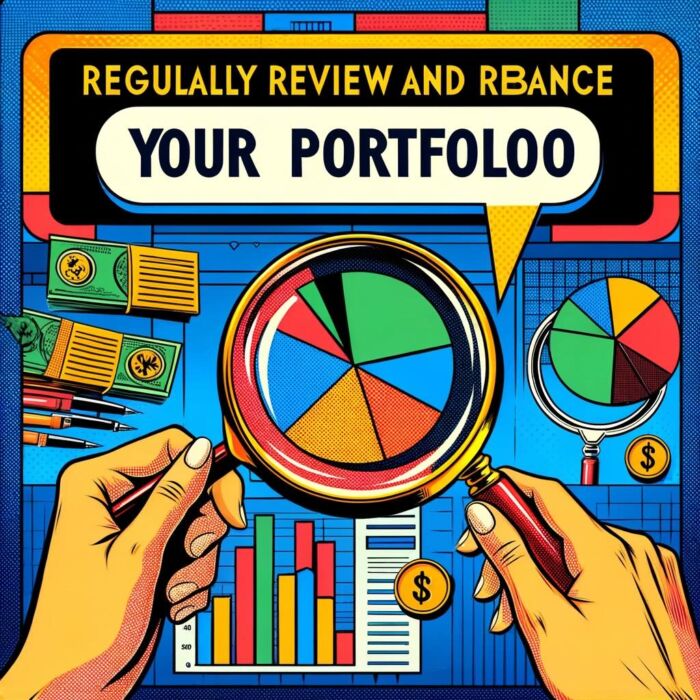Investing can be a challenging and often emotional experience. With the constant ups and downs of the market, it’s easy to get caught up in the hype and make impulsive decisions that can lead to costly mistakes. However, with discipline and a plan, investors can achieve long-term success and reach their financial goals. In this article, we will explore the top 10 tips for becoming a more disciplined investor.

Tips For Becoming A More Disciplined Investors

Investing can be an exhilarating and satisfying adventure, but it can also be a daunting and unpredictable journey. It requires discipline, patience, and a long-term perspective. But the good news is that with the right mindset, habits, and strategy, you can become a more disciplined investor and achieve your financial aspirations.
Imagine waking up every day with a clear purpose and plan for your investments. You know your investment goals, risk tolerance, and time horizon. You have a diversified portfolio that aligns with your plan and reflects your values and vision. You feel confident and empowered to make informed decisions based on your research, analysis, and intuition.

Not Swayed By Market Trends Or Fads
You are not swayed by the latest market trends or fads. You don’t succumb to fear, greed, or peer pressure. You stick to your plan, even when it seems counterintuitive or unpopular. You embrace volatility as an opportunity to buy low and sell high, rather than as a reason to panic or sell out.
You are also not complacent or arrogant. You continue to learn, grow, and adapt to changing market conditions and personal circumstances. You seek feedback, advice, and mentorship from trusted sources, and you give back to your community by sharing your knowledge and resources.
Becoming a more disciplined investor is not a one-time event, but a lifelong journey. It requires passion, creativity, and attention to detail. It also requires resilience, empathy, and humility. But it’s worth the effort, because the rewards are not just financial, but also personal and social. So, are you ready to embark on this exciting adventure?
source: Investor’s Business Daily on YouTube

1) Set clear investment goals
Setting clear investment goals is an essential part of disciplined investing. Without clear goals, it’s easy to get sidetracked by short-term fluctuations in the market or the latest investment fads. When you set clear investment goals, you have a framework for making informed decisions and can avoid making impulsive decisions that may not align with your overall investment strategy.
To set clear investment goals, start by asking yourself what you hope to achieve through investing. Do you want to build wealth for retirement? Save for a down payment on a house? Pay for your child’s education? Once you have a clear idea of your goals, it’s important to establish a timeline for achieving them. This will help you determine how much you need to invest and how long you have to achieve your goals.

Investing Goals That Are As Clear As Possible
Your investment goals should be specific, measurable, and achievable. For example, a specific goal might be to save $500,000 for retirement in 20 years. This goal is measurable because you can track your progress over time, and it’s achievable if you have a solid investment strategy in place.
It’s also important to consider your risk tolerance when setting investment goals. Are you comfortable with high-risk, high-reward investments, or do you prefer a more conservative approach? Understanding your risk tolerance will help you determine the types of investments that are best suited to your needs.
Once you’ve established clear investment goals, it’s important to regularly review them to ensure that they remain aligned with your overall investment strategy. As your goals change over time, your investment strategy may need to be adjusted accordingly.
By setting clear investment goals, you can stay focused and disciplined in your investing approach. You’ll have a roadmap for making informed decisions and will be better equipped to resist the temptation to make impulsive decisions based on short-term market fluctuations.

2) Create a well-diversified portfolio
Creating a well-diversified portfolio is a crucial aspect of disciplined investing. Diversification refers to the practice of spreading your investments across a range of asset classes, such as stocks, bonds, real estate, and commodities, to reduce your overall risk and improve your chances of long-term success.
One of the primary benefits of diversification is that it can help mitigate the impact of market volatility. By investing in multiple asset classes, you can reduce your exposure to any one particular investment or sector. For example, if you invest solely in technology stocks and the tech sector experiences a downturn, your portfolio will be significantly impacted. However, if you have also invested in other sectors, such as healthcare or consumer staples, your overall portfolio may be less affected.
Another benefit of diversification is that it can help improve your returns over the long run. While some investments may experience periods of significant growth, others may lag behind. By investing in a mix of assets, you can potentially capture the returns of multiple markets, rather than relying on the success of a single investment.

Diversification Can Improve Long-Term Returns
When building a diversified portfolio, it’s important to consider your risk tolerance and investment goals. Generally, investors with a higher risk tolerance may choose to allocate a greater portion of their portfolio to higher-risk investments, such as stocks or real estate, while those with a lower risk tolerance may choose to allocate more to lower-risk investments, such as bonds.
It’s also important to consider the level of diversification within each asset class. For example, within the stock market, you may choose to invest in a mix of large-cap and small-cap stocks, or domestic and international stocks. Within the bond market, you may choose to invest in a mix of government and corporate bonds, or short-term and long-term bonds.
In addition to diversifying your investments by asset class and within each asset class, it’s also important to regularly rebalance your portfolio. Over time, certain investments may outperform others, leading to an imbalanced portfolio. By rebalancing your portfolio regularly, you can ensure that your investments remain aligned with your goals and risk tolerance.
In summary, creating a well-diversified portfolio is a key component of disciplined investing. By spreading your investments across a range of asset classes and regularly rebalancing your portfolio, you can reduce your overall risk and improve your chances of long-term success.
source: Value Investing with Sven Carlin, Ph.D. on YouTube

3) Stick to a long-term investment plan
Sticking to a long-term investment plan is a crucial aspect of disciplined investing. When it comes to investing, it’s easy to get caught up in the short-term fluctuations of the market and make impulsive decisions based on fear or greed. However, a disciplined investor understands the importance of maintaining a long-term perspective and sticking to their investment plan, even during turbulent times.
One of the key benefits of having a long-term investment plan is that it helps you avoid the temptation to make emotional decisions in response to short-term market movements. Instead, you can focus on the big picture and make decisions based on your long-term goals and the fundamentals of your investments.
To develop a long-term investment plan, start by setting clear investment goals and a timeline for achieving them. Your goals should be specific, measurable, achievable, relevant, and time-bound (SMART).

SMART Investing Goals
For example, your goal may be to save $1 million for retirement by the age of 65, or to save enough money to pay for your child’s college education in 10 years.
Once you have established your goals, you can develop a plan to achieve them. This may involve determining how much money you need to save each month, choosing the right investment vehicles for your portfolio, and deciding how much risk you are willing to take on.
It’s important to note that a long-term investment plan should be flexible and adaptable to changes in your life circumstances or the market. You may need to adjust your plan if you experience a significant life event, such as a job loss or unexpected medical expenses, or if you experience a significant market downturn.
In addition to sticking to your long-term investment plan, it’s also important to stay disciplined in your approach to investing. This means avoiding impulsive decisions and sticking to your investment strategy, even when it may be tempting to make a change.
Overall, sticking to a long-term investment plan is a critical component of disciplined investing. By focusing on your long-term goals and avoiding short-term distractions, you can build a strong foundation for successful, disciplined investing.
source: Rule #1 Investing on YouTube

4) Avoid emotional decision-making
Avoiding emotional decision-making is a crucial aspect of being a more disciplined investor. As an investor, it’s easy to get swept up in market fluctuations and make impulsive decisions based on fear or greed. However, it’s important to keep in mind that emotions can cloud your judgment and lead to poor investment decisions.
One of the keys to avoiding emotional decision-making is to have a clear investment plan in place. This plan should include your investment goals, risk tolerance, and time horizon. By having a plan, you can avoid making knee-jerk reactions to short-term market movements and instead focus on the long-term performance of your portfolio.
Keep Your Emotions At Bay
Another way to avoid emotional decision-making is to stay informed about the market and your investments. This means keeping up with financial news, regularly reviewing your portfolio, and staying up-to-date on market trends and economic indicators. By having a solid understanding of the underlying factors driving market movements, you can make more informed investment decisions and avoid being swayed by short-term volatility.
It’s also important to remember that investing is a marathon, not a sprint. Successful investors take a long-term view and stay focused on their goals, even in the face of short-term fluctuations. By keeping your emotions in check and sticking to a disciplined investment plan, you can avoid making impulsive decisions that can derail your long-term investment success.
source: Anthony Pompliano on YouTube

5) Keep A Cool Head During Market Downturns
As an investor, it’s essential to keep your emotions in check, especially during market downturns. It’s common for people to panic when they see their investments losing value, but it’s crucial to maintain a level head and not make any hasty decisions.
One of the most effective ways to stay disciplined during market downturns is to have a solid investment plan in place. Your investment plan should be focused on your long-term goals, and it should be designed to weather the ups and downs of the market.
When the market takes a dip, it’s important to avoid knee-jerk reactions like selling all your investments or buying more of a particular stock. Instead, take the time to reassess your portfolio and ensure that it’s still aligned with your long-term goals. Ask yourself whether the downturn is likely to be temporary or whether it represents a more significant shift in the market.
Remind Yourself Of Long-Term Investing Goals
If you’re feeling anxious about the state of the market, it may be helpful to take a step back and revisit your investment plan. Remind yourself of your long-term goals and why you chose your particular investment strategy. This can help you stay focused and avoid making impulsive decisions.
Another way to keep a cool head during market downturns is to stay informed about what’s happening in the market. Keep up with financial news and market trends, and seek out the advice of trusted financial professionals. This can help you gain perspective on the situation and make informed decisions about your investments.
Ultimately, the key to staying disciplined during market downturns is to keep your emotions in check and stick to your long-term investment plan. Remember that market downturns are often temporary, and maintaining a disciplined approach can help you weather the storm and emerge on the other side with a strong, well-positioned portfolio.

6) Avoid Timing The Market
Timing the market refers to making investment decisions based on trying to predict when the market will rise or fall. Many investors try to time the market in the hopes of buying low and selling high, but this approach is generally not recommended for the average investor. In fact, trying to time the market can be a dangerous game that leads to poor investment decisions and significant losses.
To be a more disciplined investor, it’s important to avoid the temptation to time the market. Instead, focus on building a well-diversified portfolio that is aligned with your long-term investment goals. By taking a disciplined approach and sticking to a long-term investment plan, you can help ensure that you are well-positioned to weather market volatility and achieve your financial objectives.
One of the biggest risks of trying to time the market is that it can lead to emotional decision-making. When investors try to time the market, they often become too focused on short-term fluctuations in the market, rather than the long-term fundamentals of their investments. This can lead to impulsive decisions based on fear, greed, or other emotions, rather than sound investment principles.

Fear And Greed Are The Enemy
In addition, trying to time the market can lead to missed opportunities. Investors who try to time the market may miss out on significant gains if they are not invested in the market at the right time. Furthermore, trying to time the market often leads to higher trading costs and taxes, which can eat into your returns over time.
Instead of trying to time the market, a more disciplined approach is to focus on building a well-diversified portfolio that is aligned with your long-term investment goals. This means choosing investments that are appropriate for your risk tolerance, time horizon, and financial objectives, and sticking with them over the long term.
By avoiding the temptation to time the market, you can help ensure that you are taking a disciplined approach to investing that is focused on your long-term financial success. Remember, investing is a marathon, not a sprint, and taking a patient, disciplined approach can help you achieve your financial goals over time.
source: Prana Wealth on YouTube

7) Regularly Review And Rebalance Your Portfolio
Regularly reviewing and rebalancing your investment portfolio is a critical component of disciplined investing. Over time, the investments in your portfolio may shift in value, resulting in an imbalanced allocation of assets. To maintain a disciplined approach, it’s important to review your portfolio regularly and ensure that it is still aligned with your investment goals.
Rebalancing involves selling or buying assets to restore your portfolio’s original asset allocation. For example, if your original allocation was 60% stocks and 40% bonds, but after a year, the stocks have increased in value to make up 70% of the portfolio, you may need to sell some of your stocks and buy more bonds to bring your portfolio back to its original allocation.
Rebalancing can help you avoid becoming overexposed to certain assets and can reduce your overall risk. It can also help you avoid the temptation to chase after hot trends or make impulsive decisions based on short-term market movements.
Don’t Be Overexposed To One Asset
To rebalance your portfolio, start by reviewing your investment goals and timeline. Determine if your current portfolio allocation still aligns with those goals. If not, identify the assets you need to sell or buy to restore your original allocation.
It’s important to note that you don’t need to rebalance your portfolio too frequently. In fact, too much rebalancing can result in unnecessary transaction fees and taxes. Generally, it’s recommended to rebalance your portfolio every six months to a year.
Regularly reviewing and rebalancing your investment portfolio can help you stay disciplined and focused on your long-term investment goals. By ensuring that your portfolio remains well-diversified and aligned with your objectives, you can reduce your overall risk and increase your chances of long-term success.
source: Axia Futures on YouTube

8) Avoid Overtrading At All Costs
Avoiding overtrading is an essential aspect of being a disciplined investor. Overtrading refers to the excessive buying and selling of securities in a short period of time, which can lead to unnecessary transaction costs and taxes, and also increase the risk of making poor investment decisions.
Here are some tips to help avoid overtrading:
- Stick to your investment plan: Having a well-thought-out investment plan with clear objectives and guidelines can help you avoid impulsive trading decisions. Make sure to follow your plan and resist the temptation to make quick changes based on short-term market movements.
- Use stop-loss orders: Stop-loss orders can be a useful tool to help limit your losses and prevent you from overtrading. By setting a predetermined price at which to sell a security, you can reduce the risk of emotional decision-making and avoid holding on to losing positions for too long.
- Focus on long-term trends: Instead of getting caught up in short-term market movements, focus on long-term trends and the fundamentals of the companies you are invested in. This can help you make more informed investment decisions and avoid the urge to trade excessively.
- Limit your trading activity: Set limits on the number of trades you make in a given period of time, such as a month or a quarter. This can help you avoid the temptation to trade excessively and encourage a more disciplined approach to investing.
- Monitor your portfolio regularly: Keep a close eye on your portfolio and monitor your investments regularly to ensure they are still aligned with your goals and investment plan. This can help you identify potential issues early on and avoid making hasty decisions.
By avoiding overtrading, you can maintain a disciplined approach to investing and increase your chances of achieving your long-term investment objectives. Remember that investing is a marathon, not a sprint, and discipline and patience are key to long-term success.
source: Rule #1 Investing on YouTube

9) Practice Patience And Discipline
As an investor, you must practice patience and discipline to make informed and profitable investment decisions. The stock market is volatile, and it’s not uncommon for investors to panic and make impulsive decisions based on emotions rather than logic. To avoid making hasty decisions that could jeopardize your financial goals, it’s crucial to maintain a disciplined approach to investing.
Patience and discipline are two of the most valuable traits you can possess. They allow you to make rational and informed decisions, instead of being swayed by emotions or short-term fluctuations. However, practicing patience and discipline is not always easy. It requires a conscious effort to control your impulses and to stay committed to your long-term goals. Here are some tips on how to cultivate patience and discipline as an investor.
Manage Your Emotions At All Times
It’s paramount you learn to manage your emotions. Don’t let fear or greed dictate your actions. Recognize that investing is a long-term game and that short-term fluctuations are normal. Stay focused on your plan, and resist the temptation to make sudden changes to your portfolio. Remember, it’s better to be consistent than to be reactive.
Be patient. Yup. Rome wasn’t built in a day, and neither is wealth. Investing requires a long-term perspective and a steadfast commitment to your goals. Don’t be discouraged by setbacks or temporary downturns. Stay the course, and trust in your plan. Over time, your patience and discipline will pay off.
In conclusion, practicing patience and discipline as an investor is not an easy task, but it is a rewarding one. By creating a solid plan, staying informed, managing your emotions, and being patient, you can cultivate these valuable traits and achieve your long-term goals. Remember to stay true to your values, trust in your instincts, and enjoy the journey. Investing is a marathon, not a sprint, and the finish line is worth the wait.
source: Jordan Welch on YouTube

10) Seek Professional Advice When Needed
Seek professional advice when needed is a crucial tip to become a more disciplined investor. Investing can be complex, and seeking the advice of a professional can help you make informed decisions and avoid costly mistakes. A financial advisor can provide guidance on creating a long-term investment plan, diversifying your portfolio, and staying disciplined during market volatility. They can also help you assess your risk tolerance and make adjustments to your portfolio as your goals and circumstances change over time.
Financial Advisors Can Help
It’s important to note that not all financial advisors are created equal, so it’s essential to do your research and find someone who has experience and a track record of success. Look for a licensed professional who operates on a fee-based model rather than commission-based, which can create conflicts of interest. You should also feel comfortable communicating openly with your advisor and trust that they have your best interests in mind.
While seeking professional advice can be an added expense, it’s important to weigh the potential benefits of having a trusted advisor on your side. They can provide invaluable guidance and support, and help you stay disciplined and focused on your long-term investment goals.
source: The Evidence-Based Investor

Final Thoughts On Becoming A Disciplined Investor
In conclusion, becoming a more disciplined investor is not an easy feat, but it is a worthwhile and fulfilling journey. It requires commitment, patience, and discipline, but it also demands passion, creativity, and grit. It’s a process that involves both art and science, both heart and mind.
If you want to become a more disciplined investor, you need to start by defining your purpose and plan. You need to know your goals, values, and vision. You need to create a diversified portfolio that aligns with your plan and reflects your personality and style. You need to learn from your mistakes and successes, and you need to seek feedback and advice from trusted sources.
But above all, you need to cultivate your passion and creativity. You need to love what you do, and you need to be curious and open-minded. You need to explore new ideas, technologies, and trends, and you need to challenge yourself and others. You need to be bold and daring, but also humble and empathetic.
Be Passionate And Do What You Love
As you embark on this exciting and rewarding journey, remember that you are not alone. You are part of a community of passionate and disciplined investors who share your aspirations and challenges. You have access to a wealth of resources, tools, and insights that can help you achieve your goals and dreams. And you have the power to make a positive impact on yourself, your loved ones, and your society.
So, let your passion guide you, your discipline shape you, and your creativity inspire you. Let your personality shine through, and let your voice be heard. Let’s make the world a better place, one investment at a time.
Becoming a more disciplined investor is a process that requires commitment, patience, and discipline. By following these top 10 tips, investors can ensure success on a long-term time horizon.
Important Information
Investment Disclaimer: The content provided here is for informational purposes only and does not constitute financial, investment, tax or professional advice. Investments carry risks and are not guaranteed; errors in data may occur. Past performance, including backtest results, does not guarantee future outcomes. Please note that indexes are benchmarks and not directly investable. All examples are purely hypothetical. Do your own due diligence. You should conduct your own research and consult a professional advisor before making investment decisions.
“Picture Perfect Portfolios” does not endorse or guarantee the accuracy of the information in this post and is not responsible for any financial losses or damages incurred from relying on this information. Investing involves the risk of loss and is not suitable for all investors. When it comes to capital efficiency, using leverage (or leveraged products) in investing amplifies both potential gains and losses, making it possible to lose more than your initial investment. It involves higher risk and costs, including possible margin calls and interest expenses, which can adversely affect your financial condition. The views and opinions expressed in this post are solely those of the author and do not necessarily reflect the official policy or position of anyone else. You can read my complete disclaimer here.






